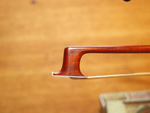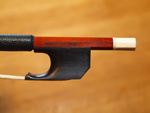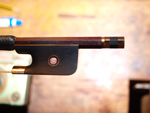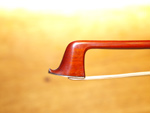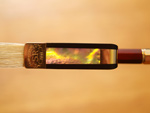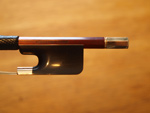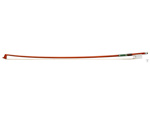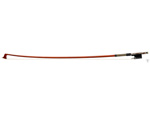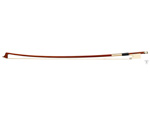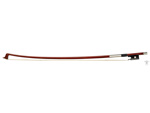Individually Crafted Bows of the Highest Quality
In my studio, I create bows of the highest quality and each one is unique. All models can be made either as violin, viola, cello or bass bows and they are completely crafted by hand.
While working on a bow, I like to confer with the future owner, in order to define and optimize features such as weight, winding, and curvature. Naturally, you can also depend on my skill and experience for the repair and restoration of your own bow.
In addition to creating modern bows, I also reproduce historical ones; Baroque or transitional Cramer bows for example.
For my bows, I exclusively use certified natural materials, whether it be pernambuco, ebony and mother-of-pearl, or ivory, goat's leather and horsehair.
- The Avantgarde Model:
- Individually produced one-off models that stand out among the world of bows with the visual appearance of the frog. The frogs are manufactured from the finest ebony as well as specially-selected and certified ivory, whereby the balance of the bow can be defined much more individually, depending upon the desire of the musician. The finish of the stick and the head conform with the highest possible demands.

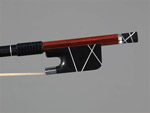
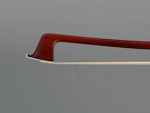


- The Julian Model:
- This very exceptional master bow meets the highest demands of the professional string player and is completely hand-crafted by the master bow maker in the traditional manner. It delights with its well-balanced playing characteristics and authoritative appearance. The bow stick is made of highest quality pernambuco wood which is seasoned for 50 years. The stick is round or can be octagonal if so desired. Pristine elegance embellished by superb components, such as finest ebony and patterned green mother-of-pearl, characterize the frog and silver fittings. They are further enhanced with a three-part button and a Parisian eye.
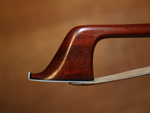
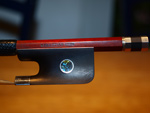
- The Lukas Model:
- This outstanding master bow meets every expectation of the professional string player. The bow is made by hand in the traditional manner and modeled on one by Eugène Nicolas Sartory. The bow stick is made from high quality pernambuco wood aged 30 years. It has balanced playing characteristics and is authoritative in appearance. It is round, or octagonal if so desired. Pure elegance, accented by outstanding components, characterize the frog and silver fittings. Finest ebony and patterned green mother-of-pearl are enhanced by a capsule button and a Parisian eye.

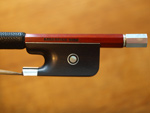
- The Jonas Model:
- This bow will assure a high degree of playing pleasure, and is particularly suited for music students. The wood is seasoned for 20 years before it can be selected for a bow of this quality. The metal fittings are made of silver, the frog of African ebony that is inlayed with a mother-of-pearl eye. The well-finished appearance is completed with a three-part button.
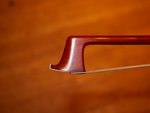
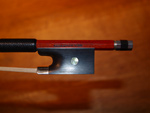
- The Gold Model:
- Made specifically for the discriminating professional artist, every one of these superb bows is a unique work of art. Together with the bow maker, the musician selects the materials and components, and he determines which type of bow is to be modeled. Curvature, elasticity, centre of gravity, etc. are carefully studied. Even the color and the gold content (14 or 18 carats) may be chosen by the client.
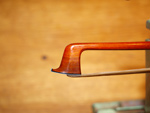

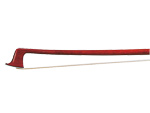
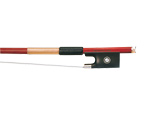
- The Ouchard Bow:
- This exceptional hand-made bow is modeled after a bow by the great French bow maker, Émile Auguste Ouchard and bears the stamp "Mdle. Ouchard à Paris". This master bow combines perfect balance and hand-crafted aesthetics. It is equipped with a specially designed "Ouchard" mount for the frog. The fine metal fittings are of silver, and are reproduced from the original bow. The ebony frog bears a Parisian eye and a capsule button, as well as silver thread wrapping.
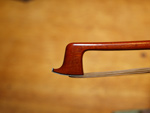
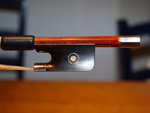
- Baroque Bows:
-
The exact shape of a Baroque bow is hard to determine in our times, since highly differing bows were used all over Europe during that period.
The weight of Baroque violin bows varies considerably. The lighter (shorter) bows start at 35 grams, longer light bows weigh from 52 to 58 grams.
Therefore, this type of bow is fashioned in accordance with the musician's wishes, and from the materials he desires.


- Cramer Bows:
-
The title "Cramer Bow" is an attempt to describe certain bow models made at the end of the 18th Century. Often referred to as a "transitional bow", this term reveals its true identity: a bow from the transitional period between the Baroque and Classical eras (about 1780 to 1820).
Characteristic of bows of this period is their clearly inward curvature, towards the hair (concave).
The length of a Cramer Bow is 73 cm., as with modern bows. The frog does not yet have metal parts nor a frog slide. The button is of ivory and the pernambuco wood utilized for this model has been seasoned for at least 30 years.
